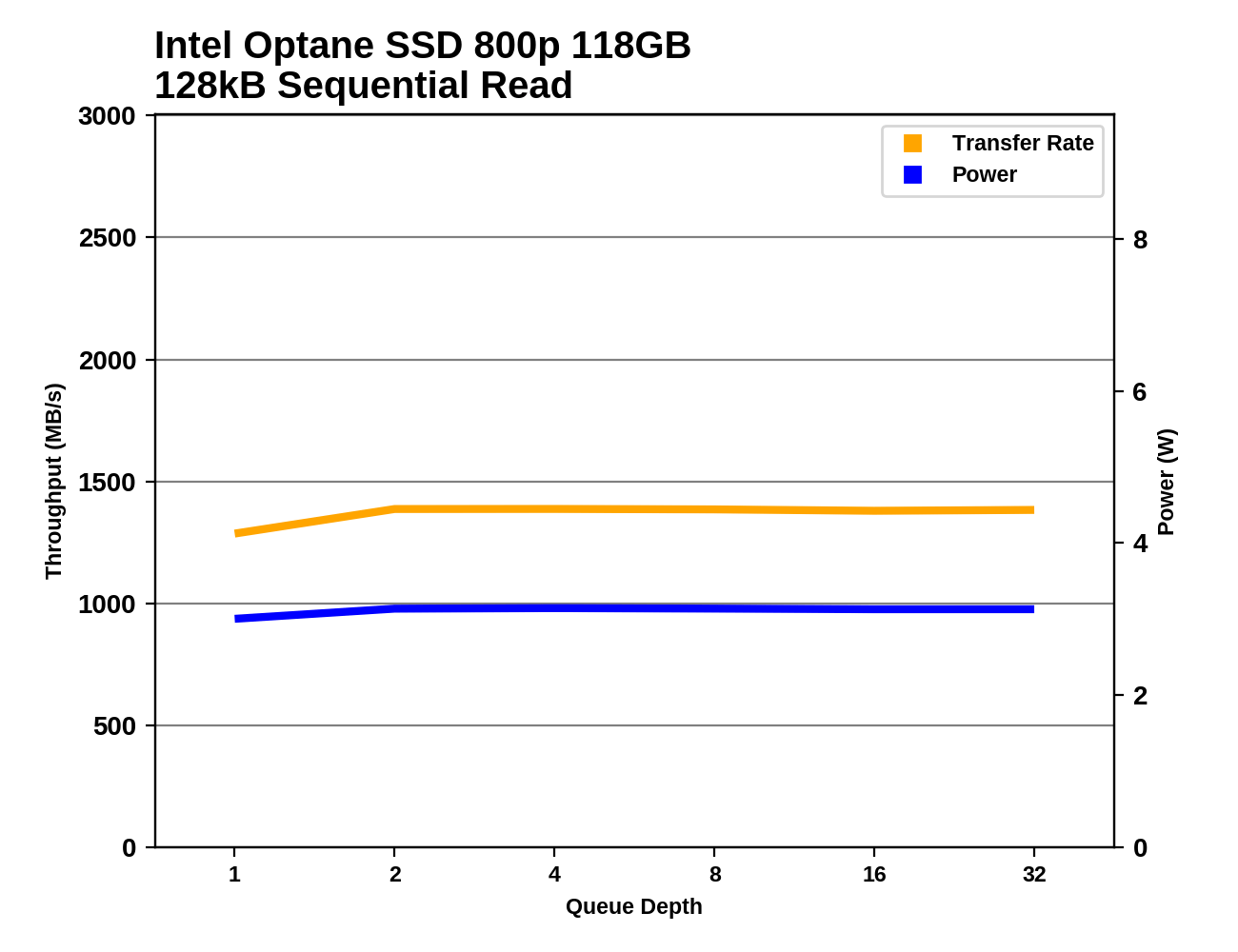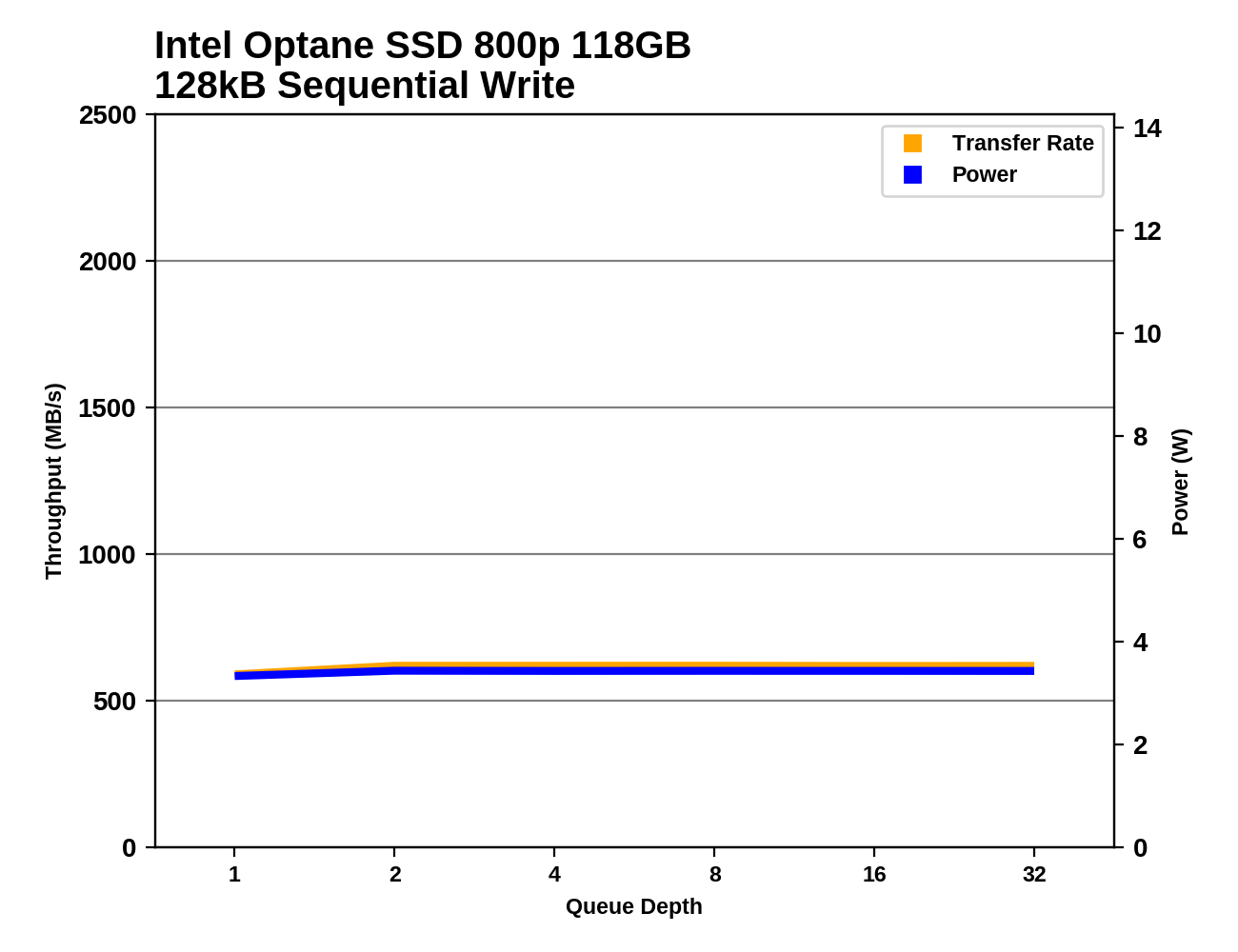The Intel Optane SSD 800p (58GB & 118GB) Review: Almost The Right Size
by Billy Tallis on March 8, 2018 5:15 PM ESTSequential Read Performance
Our first test of sequential read performance uses short bursts of 128MB, issued as 128kB operations with no queuing. The test averages performance across eight bursts for a total of 1GB of data transferred from a drive containing 16GB of data. Between each burst the drive is given enough idle time to keep the overall duty cycle at 20%.

The QD1 burst sequential read performance of the Intel Optane SSD 800p is close to their rated maximum throughput, but they are far behind the 900p and high-end Samsung drives that actually need more than two PCIe lanes.
Our test of sustained sequential reads uses queue depths from 1 to 32, with the performance and power scores computed as the average of QD1, QD2 and QD4. Each queue depth is tested for up to one minute or 32GB transferred, from a drive containing 64GB of data.

On the longer sequential read test, the Samsung NVMe SSDs fall down to the level of the Optane SSD 800p, because the flash-based SSDs are slowed down by some of the data fragmentation left over from the random write test. The Optane SSDs performed those writes as in-place modifications and thus didn't incur any fragmentation. This leaves the Samsung 960 PRO 2TB barely faster than the 800p, while the 900p runs away with its lead.

The Optane SSD 800p has the clear lead in power efficiency, as its second-tier performance comes with far lower power consumption than the top-performing 900p.
 |
|||||||||
There are no big surprises with the queue depth scaling; the 800p's sequential reads are slightly faster at QD2 than QD1, but there's no further improvement beyond that. The 800p is easily staying within its 3.75 W rated maximum power draw.
Sequential Write Performance
Our test of sequential write burst performance is structured identically to the sequential read burst performance test save for the direction of the data transfer. Each burst writes 128MB as 128kB operations issued at QD1, for a total of 1GB of data written to a drive containing 16GB of data.

The burst sequential write speed of the Intel Optane SSD 800p is no better than the low-end flash-based NVMe SSDs. Without any write caching mechanism in the controller, the fundamental nature of 3D XPoint write speeds shows through. The 900p overcomes this by using a 7-channel controller, but that design doesn't fit within the M.2 form factor.
Our test of sustained sequential writes is structured identically to our sustained sequential read test, save for the direction of the data transfers. Queue depths range from 1 to 32 and each queue depth is tested for up to one minute or 32GB, followed by up to one minute of idle time for the drive to cool off and perform garbage collection. The test is confined to a 64GB span of the drive.

The Optane SSD 800p looks better on the sustained sequential write test, as all the TLC-based SSDs run out of SLC cache and slow down dramatically, while the Optane SSDs keep delivering the exact same performance.

Despite their very different sequential write throughput, the Optane SSD 900p and 800p end up with very similar power efficiency on this test. The Samsung NVMe drives are even more efficient, but only the premium MLC-based 960 PRO has a large lead.
 |
|||||||||
Almost all of the drives show no performance scaling with increasing queue depth, as large-block sequential writes can keep all the memory channels busy with only a little bit of buffering. The 900p needs at least two 128kB writes in flight to reach full throughput.










116 Comments
View All Comments
Alexvrb - Saturday, March 10, 2018 - link
Calin you are obviously too young to remember some of the early "affordable" consumer NAND SSDs. Hammer them a bit and they stalled... producing worse results than a lot of fast HDDs... especially in random writes. Sequential speeds were never a major issue that I can recall.The_Assimilator - Friday, March 9, 2018 - link
Trying to equate a NAND-to-Optane transition to the mechanical-HDD-to-SSD transition is laughable.wumpus - Friday, March 9, 2018 - link
The moment pseudo-SLC in TLC showed up, Optane was pretty much dead in the SSD market. They would presumably compete with SLC (does anybody still make it?), but TLC is the coffin nail in consumer markets.From the moment the 3d-xpoint hypetrane started, it was clear that it would try to wedge itself into the memory hierarchy, presumably between flash and DRAM, and hopes for replacing flash.
Flash isn't going anywhere, and 3d-xpoint hasn't shown the endurance needed for a fast-paging DRAM replacement. It certainly wouldn't replace *all* DRAM, but anyone who's seen a 4GB machine actually function (slow, but they do work) knows that nearly all that expensive (hopefully DDR4 will fall back to Earth) DRAM could be replaced by something sufficiently fast, but neither flash nor 3d-xpoint is quite there.
To compound the problems, Intel decided that "Optane in a DDR4 slot" would be strictly proprietary. So there are marketing/political problems trying to get manufacturers to support it as well as technical issues to make the stuff.
name99 - Friday, March 9, 2018 - link
Consumer NAND launched in an environment where it had SOME spaces where it was optimal, and so had the chance to grow. It started in phones and DAPs, then grew to ultra-laptops, and finally the desktop. Point is --- there were niches that could pay for on-going improvement.Octane is different because there is NO obvious niche that justifies continuing to pump money into it. The niche that was SUPPOSED to justify it (NV-DIMMs) is STILL MIA years after it was promised...
iwod - Friday, March 9, 2018 - link
I am all for super fast QD1 results. But so far none of the application seems to benefits from it. At least not according to test results. I am wonder, we are either testing it wrong, looking at the wrong thing, or the benefits of QD1 is over thought and bottleneck is somewhere else.And NAND continues to get bigger better and faster. We may be looking at below $100 250GB SSD this year.
iter - Friday, March 9, 2018 - link
Exactly. It is hilarious how them fanboys keep claiming that we overlook the advantages, when I explicitly state them almost every time.There are very little and far in between workloads where those advantages can translate into tangible improvement of real world performance.
When your bottleneck is a human being interacting via input devices, discrete savings of several dozens of microseconds are simply not perceivable.
Even cumulative savings are in fact not, because most of the time that data has to also be processed by the cpu, which is why synthetics aside, raw real world applications snow minuscule going from a decent ssd to a crazy fast nvme device.
sor - Friday, March 9, 2018 - link
Probably has something to do with your name calling and “it keeps getting worse and worse” when that objectively isn’t true. You come off as having an axe to grind.It is not true that this is worse and worse. The power improvements shown here are quite impressive. Low QD performance is still better than NAND by an order of magnitude, and looks to have gotten a roughly 20% improvement. Sequential read now even beats NAND.
You and others are falling over yourselves to crap on it for some strange reason, and clearly are ignoring the upsides. It’s just a product.
iter - Friday, March 9, 2018 - link
"when that objectively isn’t true"It absolutely is. It is slower than the 900p. They improved power a bit - big whoop, especially considering it came at the cost of gutting the interface by 50%.
118 GB? I bet enthusiasts all over the planet are drooling about that crazy capacity. Not to mention the smaller model...
Nobody denies the strong points, it is just that they are way too little to make this a good product.
Instead of getting bigger and faster it gets smaller and slower.
And somehow the price per GB increases.
Truly impressive.
nevcairiel - Friday, March 9, 2018 - link
If you want to go down that road, at current consumer SSD speeds (say Samsung 960 Pro), I doubt any normal user would even notice if the performance suddenly doubled (or halfed, for that matter).Does that mean we should not innovate? Perhaps consumer work-load isn't the main goal, but if you have the hardware, why not try to make a consumer product, anyway.
MrSpadge - Friday, March 9, 2018 - link
With decently fast SATA SSDs the bottleneck is almsot entirely the CPU already, unless you've got purely I/O load.